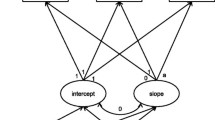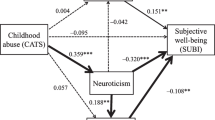Abstract.
Background:
Neuroticism measures are very popular in psychopathological research, but it is unclear how useful neuroticism is in studies of the aetiology of psychopathology.
Method:
A conceptual examination was made of the literature on the association of neuroticism and psychopathology, the ontological status of neuroticism, the purport of neuroticism questionnaires, and causal issues.
Results:
The research on which neuroticism is built has historically been based solely on the factor analyses of the common adjectives used to describe usual behaviours. An abundance of studies have shown that neuroticism scores predict life stress, psychological distress, emotional disorders, psychotic symptoms, substance abuse, physical tension-related symptoms, medically unexplained physical symptoms, and health care utilisation. This evidence suggests that neuroticism scales index vulnerability to many forms of negative affect and psychiatric disorder. However, the associations do not clarify the nature of this vulnerability nor the underlying psychobiological mechanisms. We present evidence that neuroticism scores reflect a person’s characteristic (or mean) level of distress over a protracted period of time. In this perspective, even prospective associations of neuroticism with mental health outcomes are basically futile, and largely tautological since scores on any characteristic with substantial within-subject stability will predict, by definition, that characteristic and related variables at later points in time.
Conclusion:
Neuroticism is not an explanatory concept in the aetiology of psychopathology, since it measures a person’s characteristic level of distress over a protracted period of time. This situation will not change until knowledge becomes available about: (i) the mechanisms that produce high neuroticism scores (and, therefore, also psychopathology) and (ii) its neurobiological substrate. Only then will we understand why neuroticism appears to ‘predict’ the outcomes it predicts.
Similar content being viewed by others
References
Aluja A, Garcia O, Garcia LF (2002) A comparative study of Zuckerman’s three structural models for personality through the NEO-PI-R, ZKPQ-III-R, EPQ-RS and Goldberg’s 50-bipolar adjectives. Pers Indiv Diff 33:713–726
Bolger N, Schilling EA (1991) Personality and the problems of everyday life: the role of neuroticism in exposure and reactivity to daily stressors. J Pers 59:355–386
Bolger N, Zuckerman A (1995) A framework for studying personality in the stress process. J Pers Soc Psychol 69:890–902
Bolger N (1990) Coping as a personality process: a prospective study. J Pers Soc Psychol 59:525–537
Cacioppo JT (1994) Social neuroscience: autonomic, neuroendocrine, and immune responses to stress. Psychophysiol 31:113–128
Carney RM, Freedland KE, Stein PK (2000) Anxiety, depression, and heart rate variability. Psychosom Med 62:84–87
Carney RM, Freedland KE, Veith RC, Cryer PE, Skala JA, Lynch T, Jaffe AS (1999) Major depression, heart rate, and plasma norepinephrine in patients with coronary heart disease. Biol Psychiatry 45:458–463
Claridge G, Davis C (2001) What’s the use of neuroticism? Pers Indiv Diff 31:383–400
Clark LA, Watons D, Mineka S (1994) Temperament, personality, and the mood and anxiety disorders. J Abn Psychol 103:103–116
Cloninger CR (1986) A unified biosocial theory of personality and its role in the development of anxiety states. Psychiatr Developm 4:167–226
Cloninger CR, Przybeck TR, Svrakic DM, Wetzel RD (1994) The temperament and character inventory (TCI): a guide to its development and use. Center for Psychobiology of Personality, St. Louis
Conley JJ (1984) Longitudinal consistency of adult personality: self-reported psychological characteristics across 45 years. J Pers Soc Psychol 47:1325–1333
Costa PT Jr, McCrae RR (1980) Influence of extraversion and neuroticism on subjective well-being: happy and unhappy people. J Pers Soc Psychol 38:668–678
Costa PT Jr, McCrae RR, Arenberg D (1980) Enduring dispositions in adult males. J Pers Soc Psychol 38:793–800
Costa PT Jr, McCrae RR (1986) Personality stability and its implications for clinical psychology. Clin Psychol Rev 6:407–423
Costa PT Jr, McCrae RR (1987) Neuroticism, somatic complaints, and disease: is the bark worse than the bite? J Pers 55:299–316
Costa PT Jr, McCrae RR (1991) Trait psychology comes of age. Nebr Symp Motiv 39:169–204
Costa PT Jr, McCrae RR (1992a) Normal personality assessment in clinical practice: The NEO Personality Inventory. Psychol Ass 4:5–13
Costa PT Jr, McCrae RR (1992b) The five-factor model of personality and its relevance to personality disorders. J Pers Dis 6:343–359
Duggan CF, Lee AS, Murray RM (1990) Does personality predict long-term outcome in depression? Br J Psychiatry 157:19–24
Eaves L, Heath A, Martin N, Maes H, Neale M, Kendler KS, Kirk K, Corey L (1999) Comparing the biological and cultural inheritance of personality and social attitudes in the Virginia 30,000 study of twins and their relatives. Twin Res 2:62–80
Eysenck HJ, Eysenck SBG (1968) Manual for the Eysenck Personality Inventory. Educational and Testing Service: San Diego
Eysenck HJ (1985) A genetic model of anxiety. Issues Ment Health Nurs 7:159–199
Farmer A, Harris T, Redman K, Sadler S, Mahmood A, McGuffin P (2000) Cardiff depression study. A sib-pair study of life events and familiality in major depression. Br J Psychiatry 176:150–155
Farmer A, Redman K,Harris T, Mahmood A, Sadler S, Pickering A, McGuffin P (2002) Neuroticism, extraversion, life events and depression. The Cardiff Depression Study. Br J Psychiatry 181:118–122
Fergusson DM, Horwood LJ (1987) Vulnerability to life events exposure. Psychol Med 17:739–749
Finn SE (1986) Stability of personality self-ratings over 30 years: evidence for an age/cohort interaction. J Pers Soc Psychol 50:813–818
Folkman S, Lazarus RS (1988) The relationship between coping and emotion: implications for theory and research. Soc Sc Med 26:309–317
Friedman HS (2000) Long-term relations of personality and health: Dynamism, mechanisms, tropisms. J Pers 68:1089–1107
Goldsmith HH, Buss AH, Plomin R, Rothbart MK (1987) What is temperament? Four approaches. Child Dev 58:509–529
Goodwin RD, Fergusson DM, Horwood LJ (2003) Neuroticism in adolescence and psychotic symptoms in adulthood. Psychol Med 33:1089–1097
Gray JA (1981) Anxiety as a paradigm case of emotion. Br Med Bull 37:193–197
Groenink L, Pattij T, De Jongh R, Van der Gugten J, Oosting RS, Dirks A, Olivier B (2003) 5-HT1A receptor knockout mice and mice overexpressing corticotropin-releasing hormone in models of anxiety. Eur J Pharmacol 463:185–197
Gurrera RJ, O’Donnell BF, Nestor PG, Gainski J, McCarley RW (2001) The P3 auditory event-related brain potential indexes major personality traits. Biol Psychiatry 49:922–929
Hansenne M (1999) P300 and personality: an investigation with the Cloninger’s model. Biol Psychol 50:143–155
Hariri AR, Mattay VS, Tessitore A, Kolachana B, Fera F, Goldman D, Egan MF, Weinberger DR (2002) Serotonin transporter genetic variation and the response of the human amygdala. Science 297:400–403
ten Have M, Oldehinkel AJ, Vollebergh W, Ormel J (2004) Does neuroticism explain variations in care service use for mental health problems in the general population? Results from the Netherlands Mental Health Survey and Incidence Study (NEMESIS). in press, 2004
Heath AC, Martin NG (1990) Psychoticism as a dimension of personality: a multivariate genetic test of Eysenck and Eysenck’s psychoticism construct. J Pers Soc Psychol 58:111–121
Heath AC, Neale MC, Kessler RC, Eaves LJ, Kendler KS (1992) Evidence for genetic influences on personality from self-reports and informant ratings. J Pers Soc Psychol 63:85–96
Heim C, Nemeroff CB (2002) Neurobiology of early life stress: clinical studies. Semin Clin Neuropsychiatry 7:147–159
Holsboer F (2001) Stress, hypercortisolism and corticosteroid receptors in depression: implications for therapy. J Affect Disord 62:77–91
Jorm AF, Christensen H, Henderson S, Korten AE, Mackinnon AJ, Scott R (1993) Neuroticism and self-reported health in an elderly community sample. Pers Indiv Diff 15:515–521
Kagan J, Reznick JS, Snidman N (1987) Temperamental variation in response to the unfamiliar. In: Krasnegor NA, Blass EM (eds) Perinatal development: A psychobiological perspective. Academic Press, San Diego. Behav Biol, pp 421–440
Katon W, Russo J, Frank E, Barrett JA, Williams JW, Oxman T, Sullivan MD, Cornell JE (2002) Predictors of nonresponse to treatment in primary care patients with dysthymia. Gen Hosp Psychiatry 24:20–27
Kendler KS, Kessler RC, Neale MC, Heath AC, Eaves LJ (1993) The prediction of major depression in women: toward an integrated etiologic model. Am J Psychiatry 150:1139–1148
Kendler KS, Gardner CO, Prescott CA (2003) Personality and the experience of environmental adversity. Psychol Med 33:1193–1202
Kirschbaum C, Hellhammer DH (1989) Salivary cortisol in psychobiological research: an overview. Neuropsychobiol 22:150–169
Krabbendam L, Janssen I, Bak M, Bijl RV, de Graaf R, van Os J (2002) Neuroticism and low self-esteem as risk factors for psychosis. Soc Psychiatry Psychiatr Epid 37:1–6
Loehlin JC (1992) Genes and environment in personality development. Sage Publications, Thousand Oaks
Lucas RE, Fujita F (2000) Factors influencing the relation between extraversion and pleasant affect. J Pers Soc Psychol 79:1039–1056
MacLeod C, Hagan R (1992) Individual differences in the selective processing of threatening information, and emotional responses to a stressful life event. Behav Res Ther 30:151–161
McCrae RR, Costa PT Jr (1997) Personality trait structure as a human universal. Am Psychol 52:509–516
Neeleman J, Sytema S, Wadsworth M (2002) Propensity to psychiatric and somatic ill-health: evidence from a birth cohort. Psychol Med 32:793–803
Neeleman J, Bijl R, Ormel J (2004) Neuroticism, a central link between somatic and psychiatric morbidity: path analysis of prospective data. Psychol Med 34:521–531
Oldehinkel AJ, Ormel J, Neeleman J (2000) Predictors of time to remission from depression in primary care patients: do some patients benefit more from positive life change than others. J Abn Psychol 109:299–307
Ormel J (1983) Neuroticism and well-being inventories: measuring traits or states? Psychol Med 13:165–176
Ormel J, Wohlfarth TD (1991) How neuroticism, long-term difficulties, and life situation change influence psychological distress: a longitudinal model. J Pers Soc Psychol 60:744–755
Ormel J, Rijsdijk FV (2000) Continuing change in neuroticism during adulthood-structural modelling of a 16-year, 5-wave community study. Pers Indiv Diff 28:461–478
Ormel J, Oldehinkel AJ, Brilman EI (2001) The interplay and etiological continuity of neuroticism, difficulties and life events in the etiology of major and subsyndromal, first and recurrent depressive episodes in later life. Am J Psychiatry 158:885–891
Ormel J, Oldehinkel AJ, Nolen WA, Vollebergh W (2004) Vulnerability before, during, and after a major depressive episode. A three-wave population-based study of state, scar and trait effects. Arch Gen Psychiatry 61:387–392
van Os J, Jones PB (1999) Early risk factors an adult person-environment relationships in affective disorder. Psychol Med 29:1055–1067
van Os J, Jones PB (2001) Neuroticism as a risk factor for schizophrenia. Psychol Med 31:1129–1134
Plomin R, Owen MJ, McGuffin P (1994) The genetic basis of complex human behaviors. Science 264:1733–1739
Poulton RG, Andrews G (1992) Personality as a cause of adverse life events. Acta Psychiatr Scand 85:35–38
Rutter M (1987) Temperament, personality and personality disorder. Br J Psychiatry 150:443–458
Schinka JA, Busch RM, Robichaux-Keene N (2004) A meta-analysis of the association between the serotonin transporter gene polymorphism (5-HTTLPR) and trait anxiety. Mol Psychiatry 9:197–202
Sullivan PF, Kendler KS (1998) Genetic epidemiology of ‘neurotic’ disorder. Curr Opin Psychiatry 11:143–147
Surtees PG, Wainwright NWJ (1996) Fragile states of mind: neuroticism, vulnerability and the long-term outcome of depression. Br J Psychiatry 169:338–347
Tambs K, Sundet JM, Eaves L, Solaas MH, Berg K (1991) Pedigree analysis of Eysenck Personality Questionnaire (EPQ) scores in monozygotic (MZ) twin families. Behav Genet 21:369–382
Tellegen A (1985) Structures of mood and personality and their relevance to assessing anxiety, with an emphasis on self-report. In: Hussain Tuma A, Maser J (eds) Anxiety and the anxiety disorders. Erlbaum, Hillsdale, pp 681–706
Viken RJ, Rose RJ, Kaprio J, Koskenvuo M (1994) A developmental genetic analysis of adult personality: extraversion and neuroticism from 18 to 59 years of age. J Pers Soc Psychol 66:722–730
Watson D, Clark LA (1984) Negative affectivity: the disposition to experience aversive emotional states. Psychol Bull 96:465–490
Watson D, Walker LM (1996) The long-term stability and predictive validity of trait measures of affect. J Pers Soc Psychol 70:567–577
Widiger TA, Hurt SW, Frances A, Clarkin JF, Gilmore M (1984) Diagnostic efficiency and DSM-III. Arch Gen Psychiatry 41:1005–1012
Widiger TA, Trull TJ (1992) Personality and psychopathology: an application of the five-factor model. J Pers 60:363–393
Author information
Authors and Affiliations
Corresponding author
Rights and permissions
About this article
Cite this article
Ormel, J., Rosmalen, J. & Farmer, A. Neuroticism: a non-informative marker of vulnerability to psychopathology. Soc Psychiatry Psychiatr Epidemiol 39, 906–912 (2004). https://doi.org/10.1007/s00127-004-0873-y
Accepted:
Issue Date:
DOI: https://doi.org/10.1007/s00127-004-0873-y




